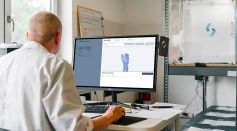Tags: 3D Printing
World’s First High-Resolution 3D-Printed Brain Developed as Model for Investigating Neurodegenerative Diseases
Functional Human Brain Tissue Developed by 3D Printing for the First Time, Shows Potential for Modeling Neural Network Impairment
Autonomous Soft Robot Navigates Disaster Zones With Plant-Inspired Adaptive Behaviors

Groundbreaking Bioprinting Ink Lets Doctors 3D Print Inside the Human Body
Novel Implant Kills 87% of Staph Infection-Causing Bacteria, Paving the Way for Safer Common Surgeries

3D-Printed Epifluidic Electronic Skin Developed by Scientists for Multimodal Health Surveillance Powered by Machine Learning

Revolutionary 3D-Printed Toilet Bowl Aims to Revolutionize Waste Management, Conserve Water with Its Ultra-Slippery Surface

3D-Printed Nose Attached to Forearm To Grow Blood Vessels Before Moving It to Patient’s Face in 6-Hour Microsurgery
3D-Printed Vegan Seafood Made From Alternative Protein Sources Offers Solution Against Harmful Fishing Technique

Programmable 3D Printed Wound Dressing Can Be Customized for Burn Patients, Cancer Treatment

Researchers Used 3D Printing To Embed Hidden Magnetic Tags Within Manufactured Hardware To Detect Counterfeit Parts

3D-Printed Eye Tissue From Stem Cells Could Lead to Breakthrough in Treating Degenerative Eye Diseases

Live Plant Cells Used in 3D Bioprinting to Study Cellular Communication That May Lead to Better Crop Varieties

100 Medical Microrobots per Minute Being Developed for Treatment Purpose; Technology Can Produce Structure With Nanometer-Level Precision

Autonomous 3D Printing Drones the First of Its Kind to Build, Repair Structures In-Flight

AI SpaceFactory Presents 3D Printing Lunar Outpost LINA in Collaboration with NASA

3D Printed Ear From Human Cells Transplanted on Female Patient
Pixelated Sheets of Soft Material Created As Simple as an Inkjet Printing Used for Rapid Production of Soft Robotic Devices

MIT Scientists Created Shape-Shifting Cube Robots for Space Exploration Based on Electromagnetism

Butterfly Wing 3D Printed to Replicate Nanostructure Color
Most Popular

Trump Administration Declares COVID-19 Likely Originated from Wuhan Lab Leak, Citing Scientific Evidence

Largest Known Volcanic Aquifer Discovered Beneath Oregon's Cascades

New 'Supergiant' Sea Bug Found in South China Sea, Named After Darth Vader

Mediterranean Sea Was Refilled by a Catastrophic Flood Millions of Years Ago





